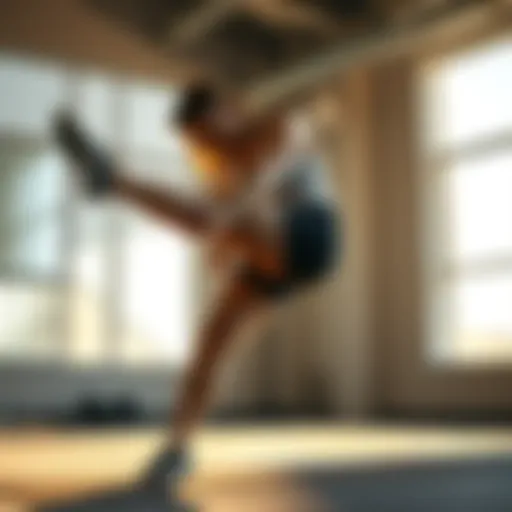Men's Comfortable Footwear: Your Ultimate Guide
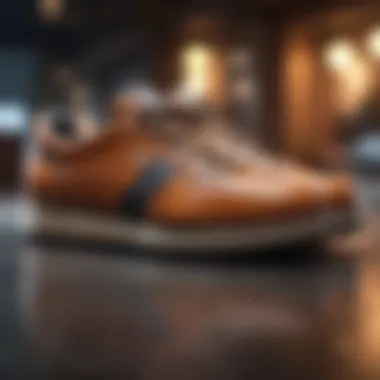

Intro
When it comes to footwear, men often find themselves caught in the crossfire between style and comfort. With a dizzying array of options at their disposal, it can be tough to determine which shoes will not only look good but also provide the long-lasting support required for an active lifestyle. Make no mistake: the right pair of shoes can enhance not only your physical health but also your overall well-being.
Exploring the myriad choices available in men's footwear isn't just a venture into fashion; it's a journey toward improving one's health. From the ground up, the shoes we wear have an impact on our bodies, particularly our feet, back, and the way we move.
Key Benefits
Choosing the right pair of shoes applies beyond mere aesthetics. It plays a vital role in physical health and mental wellness.
Physical Health Benefits
- Arch Support: Good arch support can prevent various posture problems. Properly designed shoes support the natural arch of the foot, diminishing the risk of flat feet or overpronation.
- Cushioning: Impact absorption is crucial, particularly for individuals who spend long hours on their feet. Shoes with ample cushioning reduce the stress placed on joints, thereby lowering the risk of injuries.
- Trail and Error: Whether you’re walking, running, or standing, the right footwear can cushion every step. A solid pair of shoes stands the test of time, offering durability and resilience against daily wear and tear.
- Increased Activity Levels: With comfortable shoes, you are more likely to remain active. The less foot pain you experience, the more inclined you will be to take that walk or hit the gym.
"Comfortable shoes aren't just a luxury. They are a necessity for anyone aiming to lead an active life."
Mental Well-being Enhancements
- Confidence Boost: Wearing the right shoes can enhance your posture and gait, translating into greater confidence as you strut your stuff.
- Reduced Stress: No one likes ending a day with sore feet. Comfortable shoes can reduce discomfort, allowing for a more relaxed state of mind at the end of the day.
- Mindfulness in Movement: Choosing the correct footwear encourages individuals to be more deliberate about their movements, fostering a sense of mindfulness and connection to one’s body.
- Fashion Meets Function: The marriage of style and comfort can elevate your mood. When you look good, you feel good—leading to a significant uplift in one’s overall mental state.
Practical Tips
Making informed choices about shoes does not have to be overwhelming.
Selecting the Right Fit
- Assess Your Needs: Understand what activities you will engage in most frequently. Casual walking, running, or formal events each demand different footwear characteristics.
- Try Before You Buy: Always try shoes on at the end of the day when your feet are at their largest. Walk around the store to ensure they fit snugly without being too tight.
- Check the Materials: Opt for breathable fabrics to keep your feet dry and comfortable. Leather, mesh, and synthetic materials each offer different benefits.
Maintenance Matters
- Regular Cleaning: Keeping shoes clean prolongs their life. A quick scrub can prevent wear caused by dirt buildup.
- Sole Health: Regularly inspect the soles for wear and tear. If they start to lose grip, it's time to consider replacement.
- Rotate Shoes: If possible, rotate between multiple pairs. This allows for air circulation and lets each pair regain shape.
By understanding the significance of comfort in footwear and how it influences health and well-being, one can make better informed decisions that not only cater to their style but also significantly enhance their quality of life.
Understanding Comfortable Footwear
Understanding comfortable footwear is essential for anyone looking to maintain their health and well-being, particularly in our fast-paced world. Shoes are not just a fashion statement; they significantly impact our daily lives, influencing posture, physical activity, and overall comfort. It is vital to recognize that comfort in a shoe isn’t merely about plush insoles or soft materials; it encompasses proper fit, adequate support, and the design that complements an individual’s foot shape and activity level. Failing to understand these elements can lead not only to discomfort but also to longer-term issues such as foot pain and misalignment.
Defining Comfort in Shoes
Comfort in shoes is subjective but can generally be broken down into several key components: fit, feel, and function. First off, fit refers to how well the shoe conforms to the natural shape of the foot. A shoe that is too tight or too loose can cause friction, leading to blisters or more severe foot problems.
The feel of a shoe goes beyond its outer looks. It includes the sensation a person experiences when wearing it. Quality materials such as genuine leather or breathable mesh can significantly enhance this experience. Perfect fit combined with appropriate materials leads to a shoe that feels “like a second skin.”
Closely related is function, which is about how well the shoe serves its intended purpose. For instance, a running shoe should provide enough cushioning and support to absorb shock, while a dress shoe must strike a balance between style and comfort. It is often wise to evaluate how you plan to use the shoes. Are they for long walks, office days, or leisurely outings? Knowing the primary function assists in finding those pairs that truly deliver comfort.
"The right pair of shoes can turn your daily grind into a walk in the park."
Importance of Support and Cushioning
One cannot underscore enough the importance of support and cushioning in footwear. It’s like building a house: without a solid foundation, everything else falls apart. Support in shoes primarily refers to the arch support and heel stability these items provide. A shoe that lacks proper arch support can lead to discomfort and conditions like plantar fasciitis, a notorious ailment that comes from insufficient foot support.
Cushioning is equally crucial. Quality shoes should absorb impact when the foot strikes the ground. This impact absorption is vital, especially for active individuals or those who spend long hours on their feet. Shoes with good cushioning can also help protect the joints, reducing strain on the knees and hips. To put it simply, when your feet are supported and cushioned properly, they carry you through the day in a smooth and efficient manner, paving the way for enhanced productivity and enjoyment in day-to-day activities.
Key Features of Comfortable Shoes
When it comes to selecting men’s footwear, comfort should sit at the top of the priority list. In a world where we’re often on our feet, the right pair of shoes can be the difference between a good day and a bad one. Comfortable shoes can help in various ways—from alleviating discomfort during long hours of standing to preventing chronic issues down the line. With proper attention to key features, one can ensure they’re making smart investments in their footwear choices.
Arch Support Mechanisms
Arch support is a critical aspect of any shoe designed for comfort. Your feet are unique, with different arches that influence how you walk and stand. Shoes that provide adequate arch support help in distributing body weight evenly, reducing pressure on certain foot areas. For individuals with flat feet or high arches, finding the right shoe can be the key to avoiding pain and discomfort.
Different manufacturers employ various methods to enhance arch support. For instance, some shoes feature molded footbeds, while others use contoured insoles. The right choice will depend on individual foot shape and gait. A good idea is to experiment and see what feels right. A shoe brand like Asics is known for its high-quality arch support, especially in running shoes.
After all, no one wants to walk around feeling like they’ve got a rock in their shoe.
Breathable Materials
Breathability in shoe construction is another significant feature. Fabrics influence not only comfort but also health. Materials like mesh or canvas allow air to circulate, keeping feet cool and dry. This is particularly vital for those who lead active lifestyles or anyone whose daily routine involves hours of standing or walking. Sweat build-up can lead to unpleasant odors and, worse, skin issues like blisters or fungal infections.
Moreover, with the advancements in fabric technology, many companies now offer footwear made from moisture-wicking materials. These features keep your feet not just dry but also more comfortable throughout the day. Brands like Merrell often incorporate breathable mesh in their hiking shoes, promoting airflow and moisture management—two crucial elements for comfort.
"Your feet are your foundation. Keep them comfortable, and you can conquer the world."
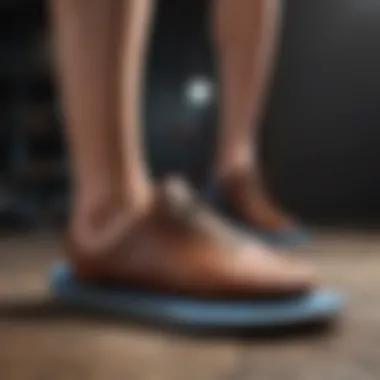

Durability Factors
A comfortable shoe isn't just about how it feels the first time you wear it. Durability plays a vital role in the long-term comfort and usability of shoes. Materials that wear out quickly can lead to problems, requiring replacements sooner than anticipated. High-quality shoes may have a higher upfront cost but can save money in the long run. Look for reinforced stitching and solid rubber soles, as these elements enhance the lifespan of the footwear.
Different activities will call for different durability needs. For everyday casual wear, shoes like Nike Air Max provide excellent cushioning and hold up over time, while specialized footwear for outdoor activities should focus on rugged construction to withstand rough terrains.
Types of Comfortable Shoes for Men
When it comes to choosing shoes, the entire topic of comfortable footwear caters not only to aesthetics but also to functionality and health. Understanding the various types can guide individuals in selecting the right pair that suits their lifestyle demands. Each category serves a distinct purpose, whether for casual outings, professional environments, or outdoor adventures.
Selecting appropriate shoes can make the difference between feeling fatigued and walking with ease. The right type of shoe can enhance support, cushion your feet, and prevent future foot-related issues. This comprehensive overview will navigate through casual, dress, and outdoor shoes to provide insight into what might fit various scenarios.
Casual Shoes
Casual shoes are the bread and butter of everyday wear. They’re designed for comfort while maintaining a laid-back style, making them versatile enough for numerous occasions.
Loafers and Slip-ons
Loafers and slip-ons represent a savvy blend of convenience and style. Their lack of laces means you can easily slide in and out without fuss. One could argue that they are the epitome of minimalism in footwear. A key characteristic of these shoes is their low-cut design, allowing for breathability. This feature makes them especially appealing in warmer weather.
The elegance typically associated with loafers allows them to transition from work to casual settings with grace. For instance, wearing a pair of dark leather loafers with jeans can give you that sharp, sophisticated look without needing a full suit. However, it’s worth noting that while they shine in casual or semi-formal settings, they might lack the arch support needed for prolonged standing or walking.
Sneakers and Trainers
Sneakers and trainers come with a different sort of flair. Designed primarily for functionality, they’re built to withstand the test of active lifestyles. The most significant feature of this category is their cushioned footbed, often incorporating advanced materials that offer support without adding bulk.
They have become a popular choice among individuals who prioritize comfort during daily grind. For example, a runner might find that a high-quality pair of running sneakers absorbs impact effectively while preventing injuries. However, one must choose wisely – not all sneakers offer the same level of support. Some overly fashion-forward styles might prioritize looks over ergonomics.
Dress Shoes
When the occasion calls for formality, dress shoes step up to the plate. These shoes can boost one's confidence in critical settings, combining style with support.
Oxfords and Brogues
Oxfords and brogues earn their reputation due to their formalized structure. They are characterized by their closed lacing systems, which allow for a snug fit. Not only do they look polished, but they also often come equipped with cushioned insoles that provide unexpected comfort.
Their unique feature lies in the intricate detailing on the leather, especially in brogues, which offer an aura of sophistication. While they may not be the most breathable option during the summer months, they're still favored for important events where style is paramount. Just be cautious with sizing; a too-tight fit can lead to discomfort, which isn't ideal during long hours.
Derby Shoes
Derby shoes provide a slightly more relaxed feel compared to Oxfords. Their open lacing system allows for more room, which is perfect for individuals with wider feet. A significant characteristic of Derby shoes is their versatile nature. They can be dressed up for formal wear or down for a casual outing.
Their unique feature lies in their adaptability, making them suitable for a range of occasions. However, much like Oxfords, not all Derby shoes provide adequate arch support, making it critical to choose wisely according to one’s foot shape and activity level.
Outdoor and Sports Footwear
Outdoor and sports footwear are tailored more towards rugged use or specific athletic activities. They are designed to endure tougher conditions, bringing the ideal union of durability and comfort.
Hiking Shoes
Hiking shoes are designed specifically to tackle trails and challenging terrains. One of the most notable aspects is the traction they offer, thanks to rugged soles that grip the ground firmly.
Moreover, many hiking shoes come with waterproof features, ensuring that wet conditions don’t dampen your wanderlust. These shoes are invaluable for anyone spending significant time in nature. Yet, careful selection is critical as poorly fitting shoes can lead to blisters, undermining the entire outdoors experience.
Running Shoes
Running shoes can also be considered an art form of their own. Depending on the individual’s gait, there are shoes tailored for overpronators or those with a neutral gait. The cushioning found in running shoes often serves as a godsend for those pounding the pavement in their daily runs, absorbing impact vigorously.
However, runners need to factor in the longevity of the shoe; using a shoe not designed for extended wear can lead to concerning injuries. Additionally, finding a shoe that aligns with one’s unique foot mechanics is essential.
In sum, the landscape of men's comfortable shoes is rich and diverse. By understanding the different types available, one can make informed decisions that enhance comfort while aligning with lifestyle needs.
Selecting the Right Fit
Finding the right fit for comfortable shoes isn't just about choosing a size off the shelf; it encompasses an array of factors that contribute to overall comfort and foot health. Ill-fitting shoes can lead to problems like blisters, corns, or even long-term issues like plantar fasciitis. Therefore, selecting the right fit is crucial not only for day-to-day comfort but also for preventing potential health risks down the road. Here, it's beneficial to understand how to accurately measure one’s foot and the various aspects of shoe sizes and widths.
Measuring Your Foot Correctly
Before heading to the store, it’s essential to measure your foot properly. Many people think they know their size, but feet can change over time due to factors such as weight gain, aging, or even pregnancy. To get the most accurate measurement:
- Gather your tools: You only need a ruler or a measuring tape and a piece of paper.
- Trace your foot: Stand on the paper and outline your foot, making sure the pencil stays perpendicular to the paper.
- Measure the length: Use the ruler to measure from the longest toe to the heel. Record this length.
- Measure the width: Similarly, measure the widest part of your foot.
Based on these measurements, you can determine your size. If your feet have different lengths, it’s wise to choose shoes based on the larger foot. Remember, too, that foot size can vary across different brands, so always try before you buy. A well-measured foot leads to better chances of finding shoes that minimize discomfort and enhance support.
Understanding Shoe Sizes and Widths
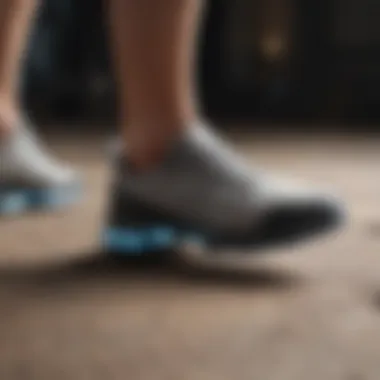

Once you have your measurements in hand, it’s time to dive into the sea of shoe sizes and widths. This might seem straightforward, but it can get a bit tricky. Here are the essentials:
- Shoe sizes can differ widely depending on the manufacturer or region. It’s not uncommon for a size 10 in one brand to feel more like a size 9 in another. While this can be annoying, it underscores the need to try on the shoes before purchasing.
- Widths often vary too. Shoes typically come in standard widths like "D" for men and "B" for women. However, some brands offer wider (usually marked as "E") or narrower options, which can impact comfort.
Utilizing the size and width of your feet, try different styles of shoes to see what feels best. Walk around in them, test them with your regular socks on, and ensure there's enough room for your toes to wiggle without feeling cramped.
"Comfort is king when it comes to footwear. If your shoes don’t fit right, you might as well be walking barefoot on rocks!"
Ultimately, selecting the right fit for comfortable shoes blends science with personal preference. It’s about finding that sweet spot where your feet feel supported yet unrestricted. The investment of time in fitting and measuring can pay big dividends in comfort and long-term health.
Lifestyle Considerations
When choosing comfortable shoes, it’s crucial to factor in your lifestyle. Your daily activities can significantly influence the kind of footwear that will meet your comfort and functional needs. Whether you are in the office, enjoying a weekend adventure, or traveling across the globe, each scenario has unique demands that should guide your shoe selections. These considerations not only enhance comfort but also support overall wellbeing.
Footwear for Specific Activities
Office Wear
Office environments often necessitate a blend of professionalism and comfort. The specific aspect of office wear revolves around maintaining a polished appearance while ensuring your feet feel good throughout the workday. Key characteristics of these shoes generally include supportive insoles and sleek designs that complement formal attire.
Unique Features such as cushioned footbeds and ergonomic designs set office shoes apart. These contribute to reducing fatigue, allowing professionals to focus on their tasks instead of discomfort. However, it’s worth noting that some office shoes can compromise on breathability, especially those made from synthetic materials. Over long hours, this may lead to overheating and moisture buildup. Therefore, investing in high-quality office footwear designed with comfort in mind is essential.
Weekend Outings
Weekend outings often call for versatility and comfort. Whether hitting up a local park or enjoying a casual dinner, shoes for these activities are vital to your overall enjoyment. The primary characteristic here is flexibility; the shoes should allow your feet the freedom to move naturally. Popular choices include slip-ons or lightweight sneakers that are easy to put on and take off.
A unique feature of weekend shoes is their adaptability – they can seamlessly transition from casual daytime wear to an evening out. While these can offer great support and comfort, one downside could be the lack of structure compared to more specialized shoes. If you’re planning to do a lot of walking, it's wise to ensure that any weekend shoes you choose still provide adequate arch support to keep you on your feet longer.
Traveling
For those who travel frequently, having the right pair of shoes can make a world of difference. The specific aspect of traveling footwear is that it needs to balance comfort, sustainability, and compactness, especially when packing light is a priority. A key characteristic of traveling shoes is their lightweight nature and the ability to quickly dry if needed, either from splashes or sweat.
With unique features like water-resistant treatments or foldability, traveling shoes cater to a range of activities from airport navigation to city exploration. However, while some may prioritize style, it’s crucial not to overlook the fit and function, as the last thing you want on a long day of travel is blisters or sore feet.
Weather-Appropriate Choices
Summer Shoes
Summer shoes play a critical role in keeping your feet cool and comfortable. The specific aspect of these shoes typically centers around breathability and moisture-wicking capabilities. A significant advantage is the lightweight materials often used, such as canvas or mesh, allowing your feet to stay ventilated during hot weather.
The unique feature of many summer shoes is their open design, which enhances airflow to the feet. However, a potential drawback is the reduced support compared to sturdier shoes. It's wise to select summer shoes that maintain some level of arch support to prevent fatigue on long, warm days spent walking.
Winter Footwear
In contrast, winter footwear must tackle the challenges cold and wet conditions bring. The essential aspect of winter shoes is insulation and waterproofing to keep your feet warm and dry. A defining characteristic of quality winter footwear is the use of thicker soles and materials designed to withstand snow and rain, which can prevent slips and falls.
A unique feature might be the traction patterns on the sole, designed specifically for icy conditions. While winter shoes often provide excellent protection, they can sometimes be heavier or bulkier than other seasonal options. It’s crucial to find a balance between warmth and usability to ensure you can move comfortably in various conditions.
Remember: The right pair of shoes can significantly improve your comfort, productivity, and enjoyment, no matter where life takes you.
Impact of Footwear on Health
When it comes to our daily lives, the significance of wearing comfortable shoes cannot be overstated. Shoes are not just about style; they play a crucial role in how we feel throughout the day. Poor footwear choices can lead to various health issues that can affect overall well-being. It's vital to understand how our footwear can impact our health, especially for those with active lifestyles or specific health considerations.
Preventing Foot Pain
Foot pain is an all-too-common complaint for many people. It can stem from a variety of sources, but the type of shoes we wear is often a major player. Supportive shoes are designed with cushioning and arch support which absorb shock. This is particularly important during walking or standing for long stretches.
Choosing shoes that fit well is also fundamental. Ill-fitting shoes may lead to blisters, bunions, or hammertoes. Look for styles that align with your foot's natural shape rather than squeezing or restricting it. For instance, shoes with a wider toe box can elminate pressure on the front of your feet. The right footwear can create a buffer against foot pain, which can ripple into sore knees and backs.
Consider the following tips to prevent foot pain:
- Invest in quality shoes made from breathable materials.
- Use orthotic insoles if you have specific foot conditions.
- Rotate your shoes regularly to give them a break.
A study by the American Podiatric Medical Association notes that over 75% of Americans experience foot pain at some point in their lives, highlighting the critical need for proper footwear.
Long-Term Foot Health
Thinking long-term, wearing proper footwear becomes an even more important consideration. The wear and tear on our feet can accumulate over time, potentially leading to serious conditions, including arthritis or chronic pain.
Shoes that fail to provide the necessary support can contribute to flat feet, high arches, or plantar fasciitis. Regularly wearing improper footwear can also result in poor posture which impacts your body alignment and can lead to back and hip issues down the road.
To promote long-term foot health, focus on:
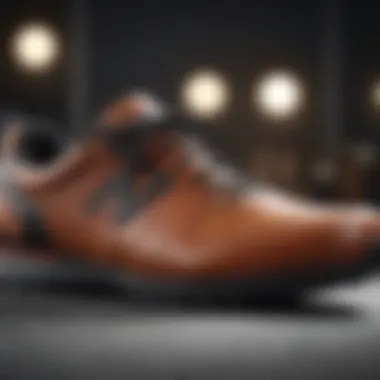

- Choosing flexible shoes that allow your foot to move naturally.
- Staying active in a way that encourages foot strength and stability.
- Listening to your body; if your feet hurt, it might be a sign to change your footwear.
In summary, being mindful of the shoes you wear is more than just an aesthetic choice; it is essential for maintaining foot health over the years. The impact of footwear on our physical health is substantial, and making informed choices could pay dividends in the long run.
Sustainability in Footwear Production
Sustainability in footwear production has grown to be an essential consideration for consumers and manufacturers alike. As the global conversation around environmental impact intensifies, the shoemaking industry finds itself at a crucial juncture. Footwear production contributes significantly to environmental degradation—from resource over-extraction to waste generation. Adopting sustainable practices is not simply a trend; it’s a clarion call for innovation in materials and processes. The pursuit of sustainability can lead to a marked reduction in the carbon footprint of shoes and can encourage healthier ecosystems.
The benefits of embracing sustainable practices are manifold. For the consumer, it translates into knowing that their choices do not burden the planet. Environmentally conscious consumers are more likely to select brands that prioritize sustainability. Thus, businesses that adapt in this way can bolster their reputation and meet the rising demand for ethical and eco-friendly products.
Eco-Friendly Materials
Choosing eco-friendly materials is a cornerstone of sustainable footwear production. Traditional materials, such as leather, often require livestock farming and chemical treatments that can be detrimental to the environment.
In contrast, manufacturers are now looking to innovative materials such as:
- Recycled plastics: Shoes made from recycled bottles are gaining traction, reducing both waste and dependence on new plastics.
- Natural fibers: Materials like organic cotton or hemp, are renewable and biodegradable, presenting a more sustainable option compared to conventional textiles.
- Vegan leathers: Alternatives made from pineapple leaves, cork, and mushroom mycelium are emerging as viable substitutes, creating a smaller ecological footprint.
By incorporating these materials, brands can produce footwear that not only reduces environmental harm but also appeals to a growing demographic of consumers keen on sustainability. When making a purchase, looking for certifications such as Global Organic Textile Standard (GOTS) or Cradle to Cradle ensures the materials meet certain eco-friendly standards.
Ethical Manufacturing Practices
Ethical manufacturing practices further complement the use of eco-friendly materials. Exploitation in labor markets, unsafe working conditions, and environmental negligence have been rampant issues in the fashion industry. However, through responsible manufacturing, companies can establish trust and transparency.
Considerations for ethical manufacturing include:
- Fair wages and working conditions: Ensuring that workers receive fair compensation and that their rights are respected. It’s imperative that labor laws are upheld.
- Local production: By producing closer to home, brands can reduce transportation emissions, while supporting local economies.
- Waste reduction techniques: Implementing strategies like zero-waste design or taking back used shoes for recycling can significantly cut down on landfill contributions.
"Sustainable footwear choices represent a journey towards a healthful lifestyle, not only for individuals but for the planet as a whole."
Integrating ethical manufacturing lends credibility to environmental efforts, ensuring brands are not only seen as trendsetters but as true stewards of the planet. By prioritizing sustainability in every aspect of production, footwear brands take vital strides towards not only preserving their industry's future but forging a healthier world.
Tips for Maintaining Comfortable Footwear
Taking care of your comfortable shoes is as important as choosing the right pair in the first place. Shoes endure a lot – from the daily grind on pavement to the scuffs that come along with everyday wear. Proper maintenance ensures that they not only look good but also continue to offer the support and comfort they originally provided. Just like you wouldn’t ignore regular check-ups for your health, your shoes deserve that same level of attention.
Here are some specific techniques and considerations to keep in mind for making sure your shoes remain in top shape for years to come.
Cleaning and Care Techniques
Keeping your shoes clean is essential. Dirt and grime can not only wear down materials; they can also affect your comfort and foot health. For different types of shoes, here are some tailored cleaning techniques:
- Leather Shoes: Wipe them down with a damp cloth to remove dirt. Use a specialized leather cleaner for deeper cleans, and follow up with conditioner to keep the material supple.
- Canvas and Fabric: A soft brush or damp cloth can work wonders here. For stubborn stains, a mild soap solution might be needed. Avoid soaking them because it can lead to unwanted odors.
- Synthetic Materials: A cloth with warm, soapy water usually does the trick. Since these are often more water-resistant, they are generally easier to clean than natural materials.
Don’t forget checked the insoles. They can trap moisture and odors. Depending on the material, you might be able to wash them in the washing machine, or you might need to just air them out regularly.
Storage Solutions
The way you store your shoes can significantly influence their lifespan. Here are some simple yet effective strategies:
- Keep them in a Cool, Dry Place: Avoid direct sunlight, as it can cause fading and degradation. Humidity can be an enemy too, so consider using boxes or containers that allow for air circulation.
- Use Shoe Trees: These can help retain the shape of your shoes, especially leather styles. They reduce creaking and can even assist with moisture control.
- Avoid Bulk Storage: Stack them carefully rather than piling them on each other. This way, you prevent misshaping and unnecessary pressures on the material.
"Take care of your shoes, and they will take care of you."
By being proactive about maintenance, you can enjoy the journey in comfort for an extended period. So don’t overlook the little things – they can make a world of difference.
Final Thoughts on Choosing Comfortable Shoes
Choosing the right comfortable shoes is not just a matter of aesthetics or following trends; it's about understanding how footwear affects your overall health and well-being. Comfortable shoes are crucial for avoiding foot pain, which can lead to a host of other health issues, including back problems and diminished mobility. This article encapsulates the vital aspects of what to consider when making your shoe choices, ensuring that they meet personal needs and daily demands.
Personalizing Your Footwear Choices
When it comes to footwear, one size does not fit all. Understanding your own feet—like arch type, width, and size—should guide your choices. A person with flat feet may need shoes that provide adequate arch support, while those with higher arches may benefit from cushioned insoles.
It's helpful to keep in mind activities you engage in regularly. If you're someone who spends long hours on your feet, look for shoes that offer excellent cushioning and support. On the other hand, if you're mostly a leisure wearer, you might prioritize style along with moderate comfort.
Don’t shy away from trying different brands and styles. Each manufacturer has a slightly different design philosophy, which means you might find that one brand’s fit perfectly aligns with your foot’s anatomy, while another might not offer the same comfort. Remember, the goal here is to listen to your feet. They often know what they want better than you do!
Balancing Style and Comfort
Finding the sweet spot between style and comfort can feel like walking a tightrope. Society often places a heavy emphasis on looks, leading many to sacrifice comfort for fashion. However, more brands are recognizing the demand for stylish yet comfortable shoes.
Here are a few tips to balance both styles:
- Material Matters: Look for shoes made from breathable materials. Not only do these keep your feet cool, they also tend to be more forgiving on the skin.
- Choose Neutral Colors: While vibrant colors can make a statement, neutrals offer versatility, allowing you to wear them in various settings, from casual outings to more formal occasions.
- Accessorize Wisely: Sometimes, pairing a simple shoe with the right accessories can elevate your entire look without sacrificing comfort.
It's essential to take time to find footwear that not only looks good but feels good too. In a world where you're constantly on the go, investing in a quality pair of shoes that meets both aesthetic and comfort levels can improve productivity and boost your confidence.
"Your shoes are an extension of your personality, and taking the time to choose wisely can make a world of difference in how you feel and move through life."
As you embark on your journey to find comfortable shoes that fit your unique lifestyle, remember that comfort should always be your compass. Paying careful attention to how shoes are made and how they interact with your body can lead to choices that enhance both health and style.



